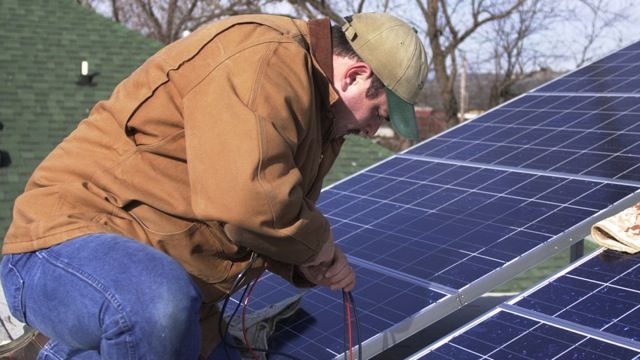This post originally appeared at The Nation.

For most Americans, typically, making sure this month’s rent gets paid unfortunately ranks higher than stopping a future sea-level rise. So in his first term, President Obama framed his environmental messages around “green jobs,” with a focus on the economic benefits of “clean tech,” rather than the less politically popular imperative to curb dirty power industries or avert the impending ecological catastrophe.
But today, with chaotic weather and collapsing infrastructure turning climate change into an immediate social and economic crisis right in our communities, can the economic arguments for a green transition go beyond jobs and toward changing the way our neighborhoods and workplaces operate?
While Washington dithers, a few enterprising towns and cities have been figuring out locally based strategies to decarbonize and revealing valuable global lessons about reorganizing their economies. In Massachusetts, the Green Justice Campaign, an offshoot of Community Labor United, an alliance of unions and advocacy groups, started with a simple plan: weatherize local homes and leverage public funds to curb carbon consumption and cut energy bills.
The organizers put grassroots muscle behind Washington’s feel-good rhetoric on the green economy and went to people’s doorsteps to recruit households and local workers, negotiated with vendors and pressed state officials to enact broad emissions-reduction standards and support for renewable energy transition. Though it operated on a small scale, the green agenda was ambitious in treating the community like an ecosystem — a collaborative climate adaptation fueled by their own labor and serving families’ material needs.
The coalition’s principles of “green justice” foregrounds economic equity for immigrants and people of color. Working-class communities of color do, after all, have a special stake in the climate change battle, since they are disproportionately burdened by the social and health problems posed by carbon-driven industries.
Under a set of new state policies aimed at promoting energy efficiency and green-technology development, the coalition crafted a weatherization project around a grassroots workforce program to give local workers a deep investment in the energy transition. Advocates worked with communities to push for structural changes in the home renovation sector, which was largely non-unionized and minimally regulated and rife with abuses such as unsafe working conditions and wage theft.
To ensure decent working conditions, the coalition built solid labor standards into the contracting process, including protections for occupational safety and regulatory oversight of workplace conditions. The coalition also helped broaden access to jobs for poor and disadvantaged workers by pushing strong protections against employment discrimination and the misclassification of workers as independent contractors. The program also included commitments by the firms to subcontract with union workers to help raise wages and job security.
In their evaluation report, the coalition concluded, “the gains we have made will ensure an estimated $14.3 million in collective wage gains for weatherization workers each year.” As more homes get fixed up, they yielded savings on residential energy bills, income gains for workers and on the environmental side, a cleaner, less carbon-heavy environment for local communities. All that in turn saved the state tens of millions of dollars, the group says, which would otherwise supported benefits like food stamps, Medicaid and, yes, home-energy subsidies.
The big data might not mean much to local families who are more worried about making rent than preserving glaciers, but Green Justice offered them a clear “value proposition:” on top of engaging officials and mainstream environmental groups, the group observed, “We also won credibility by bringing a new dimension to the discussion — equity.”
The project is modest in scale, but stands as a model of a collective social contract that connects the dignity of work and the integrity of the environment. Rational climate policy doesn’t have to be complicated, it just has to work within the complexity of human ecology, turning social tension between communities and natural resources into momentum for social change.
Labor is at the center of that equity concept. Environmental-labor coalitions advocate for high-caliber clean energy jobs programs, based on comprehensive training and apprenticeships, which track people into living wage jobs with health and retirement benefits, backed by union representation.
But a job that is labeled “green” is not necessarily better or more secure. According to a workforce analysis by Jobs for the Future, some of the workforce programs created in the wake of the Recovery Act stimulus faltered because training programs were too short-term or inadequate for tracking workers into technology-based “green collar” careers.
An investigation by Good Jobs First on the contracts awarded through the federal stimulus revealed that some companies reportedly resisted workers’ efforts to unionize, or were known to outsource production to low-wage countries. Unionization levels in the new green jobs supported by the Recovery Act are not particularly high. In this aspect, what many activists had hoped would be a Green New Deal contrasts starkly with the original New Deal labor programs, which boosted unionization and incorporated organized labor in industrial planning and regulatory policy.
But maybe the focus shouldn’t be on funneling workers into the green industries, but greening the labor movement. In Europe, where labor institutions wield more political clout, the European Trade Union Confederation (ETUC) has campaigned for a “just transition” — a social program that aims to support workers and communities affected by climate policy. While European governments have relatively strong policies on reducing emissions, labor has been a major political champion of social policies that respond to the climate crisis, including job transition programs for workers affected by an energy transition and economic supports for poor households burdened by high energy costs.
For example, labor groups across Europe have organized campaigns to push for transportation policy reforms. They see this effort as more than just a boost for green infrastructure projects; it will also benefit workers more practically, by alleviating urban pollution, promoting public transit over car dependency and easing the economic barriers facing poor and marginalized communities that are isolated from local labor markets.
Denis Benjamin, adviser to the ETUC, tells The Nation that as oil, gas and coal facilities are phased out, “we need strong social protection systems… We need also to enhance and enlarge the rights of workers to be consulted on environmental issues, energy issues within companies. We really think that the strength of social dialogue must be a tool of the transition, in order to allow workers to anticipate change and also to be drivers of this change.”
When workers gain democratic control over their energy futures, they won’t just be trying to cope with climate change, they’ll be overturning entrenched economic structures and in the process they’ll be resisting the forces that exploit their labor the same way they exploit the earth. A real green energy transition could effectively transfer power from the hierarchy of a carbon-based economy to a new system, from which workers will have a lot to gain.


